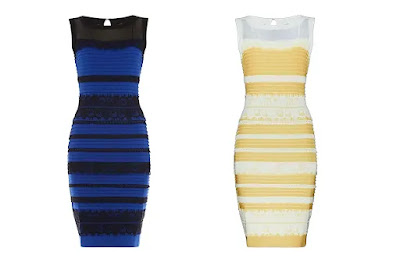Black and Blue or White and Gold?: What Does Our Brain Say?
The chokehold this dress had on social media really separated everyone into two different teams. Do you see black and blue or white and gold? This was a core memory during my teenage years because if you didn't pick the correct answer (black and blue obviously) you were judged immediately. Not in a mean way, but everyone would just ask "How do you not see black and blue?" As a teenager, you don't realize that it wasn't a competition of what you saw and what is the correct answer, we weren't taking in the fact that our brain just perceives vision differently depending on the light of the picture. In an article I read by "Wired," Adam Rogers explained how light enters the eye through the lens and has different wavelengths that go with the different colors that are being taken in. The occipital lobe is the main area of the brain that is involved with vision, which is also 30% of the cerebral cortex. Within the eye, there is the retina which is a tissue that is inside the back of the eye and has receptor cells that detect light. Rogers mentions that when light hits the retina in the back of the eye, it sends neural connections to the visual cortex in order to process those signals into an image. However, the picture of the infamous dress is a different story. Depending on how humans perceive light, whether it be day or night, the image of the dress can be perceived differently as light can bounce off it. If you take it another step further in Photoshop and mess with the RGB values, the color of the picture and dress can appear completely different. This could also be our brain completing a part of the picture and trying to replace it with a kind of color you might want to see, more so completing the picture with the concept called "visual closure."
To dive deeper into how our brain learns how to adapt to what we see, we have to understand the term "neuroplasticity." Neuroplasticity is the way the brain forms and reorganizes connections between neurons in response to changes in behavior and environment. It is how the brain is able to change and adapt to life experiences. In an audiocast I recently listened to called "How Can Going Blind Give You Vision?", we learn about a child actor from "Saved by the Bell', Isaac Lidksy, and his battle with a genetic disease that caused the cells in his retina to die off over time which would eventually lead to blindness. Something interesting that really stuck out to me was how he explained how he adapted to this disease. Lidksy said his sight became bizarre almost like a carnival house of mirrors and illusions. Objects became to look morphed and sooner or later, would almost disappear. He had to piece together parts of images he could see to just be able to pick out what he was looking at. Interestingly enough he says he learned that what we see isn't the universal truth, but a unique personal virtual reality that is constructed by our brain. Going back to neuroplasticity, in the case of Lidsky and his disease, his brain had to adapt to his disease and help complete pictures of images that he could see to help him understand what he was looking at. He mentions his struggles with his occupational therapist as she would try to help him adapt to his blindness but his anger and disbelief would make it hard for him to even cooperate with coming to terms that he will need to learn to adapt to this new lifestyle. The impact that neuroplasticity has on the human brain is that not only does it help you adapt to what your life experience is at the moment, but helps you relearn a skill and respond to new changes in your life. Lidsky did not let this disease stop him as he did graduate from Harvard and obtained a law degree. We were just able to learn how he learned to adapt to this disease and how his brain worked with him to not let his blindness completely take over. It allowed him to obtain a vision and see life with eyes wide open. He continued to live a normal life and have a family of his own.
What does this all have to do with the infamous dress? We learned that light can be perceived differently from the retina and that some people might be using visual closure to piece a picture together. There are also the effects of neuroplasticity that can alter our reality of what we are seeing from the way our brain has adapted to our lifestyle. Our brain is powerful in many ways and as vision is one of the biggest sensory systems, there are a ton of questions about what we actually see or if our brain is making things up. From listening to Lidksy and learning about the infamous dress colors, we learned that every human is different and everyone just sees things a whole lot differently as a lot of factors can come into this.
References:
Rogers, A. (2015, February 27). The science of why no one agrees on the color of this dress. Wired. https://www.wired.com/2015/02/science-one-agrees-color-dress/
Staff, N. P. R. T. E. D. (2017, January 19). How can going blind give you vision? NPR. https://www.npr.org/2017/01/20/510624029/how-can-going-blind-give-you-vision




Comments
Post a Comment